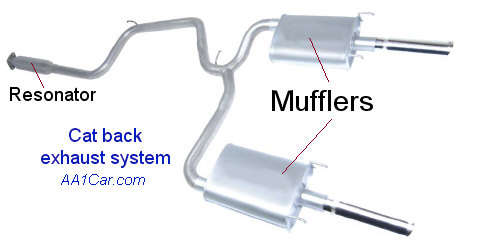
Home, Automotive Repair Library, Auto Parts, Accessories, Tools & Equipment, Manuals & Books, Car BLOG, Links, Index

Choosing A Performance Muffler
Copyright AA1Car.com


Copyright AA1Car.com
Looking for a way to improve fuel economy and increase power and performance? Replacing your stock muffler with an aftermarket performance muffler can do both.
There are inexpensive performance mufflers that are essentially a hollow shell with a couple of tubes inside or a straight through glasspack style muffler with a perforated tube wrapped with strands of fiberglass to absorb noise. Both types can significantly reduce backpressure, but the trade-off is usually a noticeably louder exhaust.
A better choice is a performance muffler that reduces power robbing backpressure without sacrificing noise control. The more expensive mufflers are better designed, have more internal baffles and sound absorbing materials, and are often made of high quality stainless steel for corrosion protection. Stainless steel mufflers are expensive, but will often last the life of your vehicle.
By reducing backpressure, a performance muffler allows the engine to breathe more freely. This increases usable horsepower and improves fuel economy. You can expect performance gains from a few percent to double digits depending on the muffler and how restrictive your old stock muffler and/or exhaust system was before you replaced it. The newfound power can make a noticeable difference when accelerating or towing. And with turbo applications, there can be a remarkable reduction in turbo lag.
Performance mufflers reduce backpressure a number of ways. Some simply remove all restrictions in the path of the exhaust (no baffles, reverse flow or diffusers to hinder flow). Unfortunately, this also hinders the muffler's ability to perform its primary function which is supposed to be noise control. Consequently, a performance muffler that gives up too much in terms of noise control to achieve ultralow backpressure readings may be too loud for anyone except a hardcore performance enthusiast. This kind of muffler may appeal to someone who equates noise with power, but it might be too loud for everyday driving.
 . . .
. . . 
There are performance mufflers that reduce backpressure without increasing noise more than a few decibels compared to stock. Such improvements are made possible by a range of design features that allow the exhaust to flow more smoothly through the muffler itself. Some of these mufflers (like Walker Dynomax mufflers) use internal flow straighteners to direct the exhaust around curves or bends inside the muffler. Others (such as Flowmax) use a unique arrangement of baffles to get just the right combination of tone, sound reduction and flow.
Some performance mufflers are designed to fit a specific vehicle application (such as a Corvette, Mustang, Honda, etc.), but many are "universal" fit mufflers that require some fabrication and cutting to install. You have to make sure the length of the new performance muffler will fit under your vehicle, and that the inlet and outlet pipe diameters are the right size to mate to your existing pipes (unless you are also replacing the stock pipes with larger diameter pipes). Pipe adapters can be used to fit almost any muffler to any exhaust system, but you should avoid changes in pipe diameter of more than about a quarter inch at the muffler inlet or outlet. Most performance mufflers come with 2-inch and larger inlets and outlets.

In addition to replacing the muffler, you should also consider replacing the entire exhaust system behind the catalytic converter. You cannot legally get rid of the converter because it is a required emission control component for street driven vehicles. But if your vehicle is for off-road only or racing, then the cat can go, too.
Cat-back performance exhaust systems are typically made of stainless steel, and are a simple bolt-on installation designed to replace the stock exhaust system. Through a complete exhaust system is expensive, it still costs less than what it would cost to have a muffler shop custom fabricate a low restriction exhaust system for your vehicle. Better yet, the suppliers of these systems have "tuned" the system to produce the best combination of sound, tone and performance for your vehicle.
In California, aftermarket mufflers and exhaust systems for late model OBD vehicle applications must have an E.O number and be certified emissions legal for street use. The same rules apply in the rest of the 49 states too. For older muscle cars, classic cars and trucks (pre-1975 model years), these rules do not apply.
If you replace your stock muffler with an aftermarket performance muffler or low restriction exhaust system, it might be too loud for local noise regulations. Many states and cities have noise limits for automotive exhaust systems. Though these rules are not strictly enforced, a cop may decide to give you a ticket if the noise coming from your tailpipe is deemed to be "excessive."
How loud is too loud? It depends on local regulations, but as a rule the limits is usually somewhere from 80 to 95 decibels at highways speeds. The limit for new vehicles is 90 decibels. In California, the noise limit for aftermarket mufflers and exhaust systems is 95 decibels. If a cop has a decibel meter and finds your vehicle is too loud, you may receive a ticket.
A warning ticket usually gives you 30 days to correct the problem. If you are not pulled over during that 30 day period for the same offense, there is usually no fine. However, if you receive a second warning ticket during that same 30-day period, or you fail to reduce the noise, you will most likely be fined.
Noise regulations generally do not apply to race cars or off-road vehicles. However, some race tracks located near housing subdivisions may have their own noise regulations to keep the noise down.
 More Muffler & Exhaust Articles:
More Muffler & Exhaust Articles: Click Here to See More Carley Automotive Technical Articles
Click Here to See More Carley Automotive Technical Articles